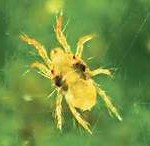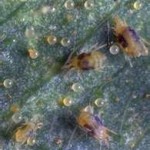One reason spider mite have become such a problem is because many insecticides used today are killing off the natural predators of spider mites. It usually takes several treatments to eliminate an infestation and this does not prevent their return within the same season. Also, most miticides do not affect eggs, requiring a repeat application approximately 10-14 days later.
Did you know that:
-
Spider mites belong to the arachnid family (along with ticks, spiders and scorpions).
- They are less than 1/20″ long, making them difficult to detect.
- Adult mites have 8 legs and an oval body.
- Their colors range from red and brown to yellow and green, depending on the species.
- The presence of webbing can be an indication of spider mite infestation.
- Spider mites prefer dry conditions.
- They live in colonies which may contain hundreds of individuals.
- They generally live on the undersides of leaves.
- They will feed on almost any plant.
- They feed by piercing the leaf tissue and sucking out the plant fluids.
- Infested leaves will become dried out and turn a yellowish-bronze color.
- Spider mites will frequently kill plants or cause serious stress to them.
- Eggs are usually laid on the underside of leaves, near the veins.
- After eggs are laid, a fine web will be weaved over them for protection.
- The female spider mite can lay up to 20 eggs a day for a couple of weeks.
- Eggs are transparent initially, and become cream colored just before hatching.
- A population of a million mites can be produced in one month by a single female.
- Spider mites can mature from egg to adult in one week.
- A female spider mite is capable of laying eggs in as little as 9 days after hatching.
Sterling Is The Solution (207) 767-5555








